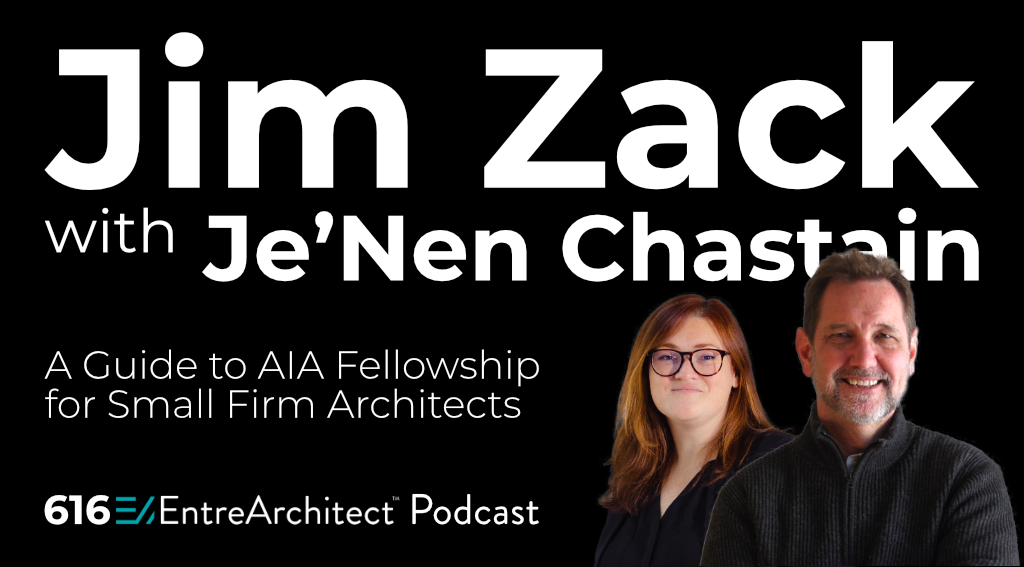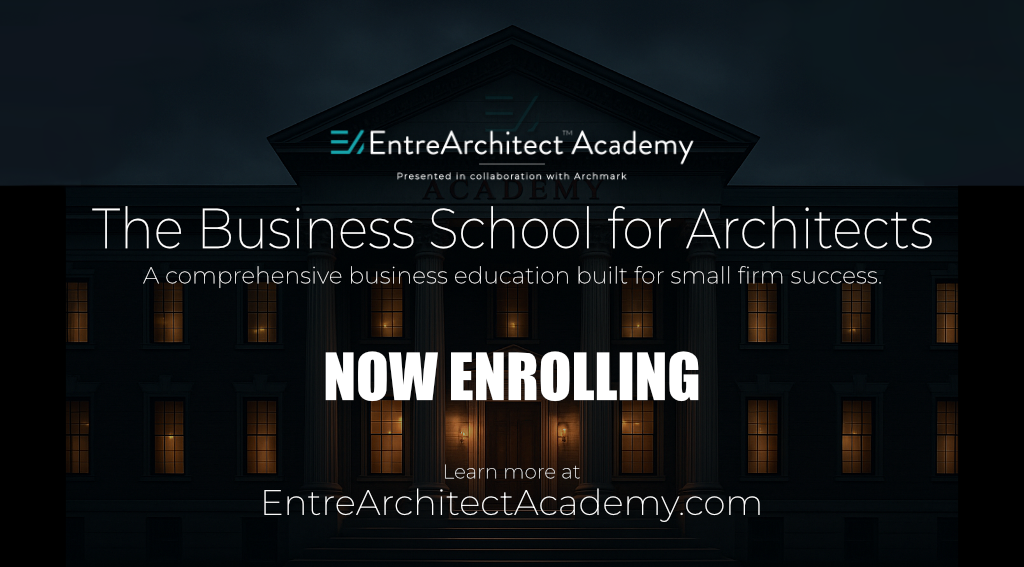
How One Architect’s Journey Illuminates the Path and Process
Every week on the EntreArchitect Podcast, I speak with people pushing our profession forward, but episode 616 felt different. When Jim Zack, FAIA, and Je’Nen Chastain joined me to unpack Jim’s recent elevation to the AIA College of Fellows, the emotion in Jim’s voice was unmistakable. He had just reached one of the highest honors an architect can achieve, and he wanted other small-firm owners to know the door is wide open for them too.
This article distills that interview and expands it with the latest information from the American Institute of Architects’ Fellowship page and 2026 application guidelines. By the time you reach the end, you will understand why Fellowship is worth pursuing, what the process really looks like, and how you can start today.
What AIA Fellowship Is—and What It Is Not
Fellowship is not a project-based award. It’s not a design award. It recognizes a career-long contribution to architecture and society. Only about 3 percent of AIA members ever earn the FAIA distinction. Candidates must prove a “ripple effect”—impact that travels beyond local practice and improves the profession at large.
That ripple might be design excellence, research, public service, leadership, or—as in Jim’s case—innovation in architect-led design-build. The AIA does not rank one path above another; it measures depth, reach, and evidence.
Jim Zack’s 35-Word “Zinger”
During the show, Je’Nen read the single sentence that opens Jim’s 40-page submission:
“Jim leads one of the most influential architect-led design-build firms in the country. His practice integrating award-winning design, construction, and craft informs and inspires clients, architects, and builders nationwide.”
Everything else in his application supported that statement. Je’Nen called it the hardest line Jim had to write—and rewrite—over the course of a year.
Quick Facts from the Fellowship Guidelines
- Submission window: June – October
- Notification: mid-February
- Public announcement: late February
- Fee: $450 (as of 2025), paid only after the online package is marked complete
- Eligibility: licensed AIA Architect member in good standing with at least ten cumulative years of membership prior to the deadline
Knowing these dates early lets you plan a practical schedule. Jim tried working in short bursts years earlier and never hit the finish line. When he finally committed, he blocked thirty hours a week for three months and still leaned on outside help.
The Six Fellowship “Objects”
AIA calls the nomination categories Objects. You must choose one primary Object and one sub-object:
- Object One – Design, Urban Design, Preservation
- Object Two – Practice Management or Technical Advancement
- Object Three – Leadership in AIA or Allied Organizations
- Object Four – Public Service, Government, or Industry Leadership
- Object Five – Alternative Careers or Volunteer Service to Society
- Object Six – Education, Research, or Literature
Jim weighed Object One (Design) seriously—his portfolio easily meets the high bar of award-winning work. Ultimately, he selected Object Two (Practice: Technical Advancement) because he wanted the submission to spotlight his architect-led design-build expertise rather than the design accolades themselves.
Nomination and Sponsorship in Plain Language
You can be nominated by either:
- Your AIA state or local chapter, or
- Five Fellows or ten licensed Architect members anywhere in the country
Most candidates lean on the first route. The chapter often supplies a Fellowship committee, document templates, and deadlines that precede the national cutoff by several months. Even with that support you still need a sponsor—typically a Fellow—who writes your lead letter and walks with you start to finish.
The Seven Reference Letters
References must reinforce your ripple effect. The guidelines ask for:
- At least five architects (Fellows preferred)
- Two additional colleagues who may be outside architecture
- Geographic, demographic, and professional diversity
Jim chose a magazine editor, a San Diego-based architect-developer he barely knew, a Cape Cod residential designer, and longtime collaborators who understood his work from different angles. The trick, Je’Nen reminded us, is sincerity. The jury can smell a name-drop a mile away.
Mapping a Realistic One-Year Schedule
Month 1 – February
Read the Fellowship site, skim three sample applications, draft your first 35-word summary.
Months 2–3
Select your Object. Outline a simple 40-page storyboard—stickies on a wall or thumbnail sketches in PowerPoint. Identify obvious content gaps.
Months 4–5
Collect high-resolution photos, publication PDFs, award certificates, speaking lists, and AIA service logs. Label every file clearly.
Months 6–7
Write narrative texts and captions. Hire a graphic designer or allocate in-house talent. Iterate weekly with your sponsor’s feedback.
Month 8
Request reference letters. Provide each writer your summary, Object, and bullet points. Set a firm due date two weeks before the national deadline.
Month 9
Proof every page. Verify word counts, file sizes, and naming conventions. Pay the $450 fee only after the portal labels the package complete.
Months 10–12
Breathe. February will bring the verdict. Use the wait to mentor emerging professionals or serve on a local committee.
Lessons from Episode 616
1. Help is not optional
Jim admitted that without Je’Nen editing copy, a designer handling layout, and peers providing critique, he would still have an unfinished folder labeled “AIA Fellowship.”
2. Your résumé is not your story
The jury wants to feel the thread connecting your projects, teaching, writing, and leadership. Je’Nen calls Fellowship a “soul-searching” exercise.
3. Impact beats fame
Jim does not run a 200-person office or design headline-grabbing museums. His influence lies in proving that small firms can marry design excellence with construction know-how at scale.
4. Fellowship is a beginning, not a finale
Receiving the medal didn’t end Jim’s pursuit of change. It sharpened his sense of responsibility. He is already mentoring others and offering to review draft applications for free.
Frequently Asked Questions (Answered with AIA Sources and Jim’s Experience)
Is Fellowship open to international AIA members?
Yes. The only hard rules are AIA membership, license, and 10 years in good standing.
Do I need national design awards?
Only if you pick Object One. Jim proved that practice innovation can carry the day under Object Two.
Can I nominate myself?
Yes, by gathering the signatures of five Fellows or ten licensed architects. You still need a sponsor’s letter.
Will Fellowship land me more clients?
It might. More important, it clarifies your purpose and expands a network that naturally leads to new opportunities.
What happens if I am not elevated?
You receive feedback and may resubmit. Many Fellows succeed on their second or third try.
A Simple Checklist to Tape Over Your Desk
- Draft 35-word summary sentence
- Choose one Object and sub-object
- Storyboard 40 pages
- Collect images and publications
- Secure sponsor
- Secure seven references
- Hire design/editorial help
- Block weekly writing time
- Upload package by October deadline
Print that list. Check off one item each week. Momentum beats inspiration every time.
How the AIA Website Reinforces Our Podcast Takeaways
The Fellowship page uses the phrase “ripple effect” throughout, mirroring the language Jim and Je’Nen used on the show. The Fellowship guidelines emphasize alignment with AIA values—equity, resilience, sustainability—threads you should weave into your evidence as naturally as you design a building for its climate.
One Action You Can Take Today
Open a blank document and spend fifteen minutes drafting your first “zinger.” It does not have to be perfect. The act of writing forces clarity, and clarity is the first paving stone on the path to Fellowship.
Listen to the Full Conversation
Words on a screen can’t convey the spark I felt when Jim described pulling his car to the shoulder of the road to email me soon after he learned of his elevation. Hear that story, plus Je’Nen’s step-by-step coaching insights, at entrearchitect.com/616.
Your work matters. Your story matters. And the College of Fellows may be closer than you think. I’m rooting for you, and if you decide to walk this path, remember Jim’s offer from the podcast: send him an email. He is ready to help you take the next step.

Leave a Reply